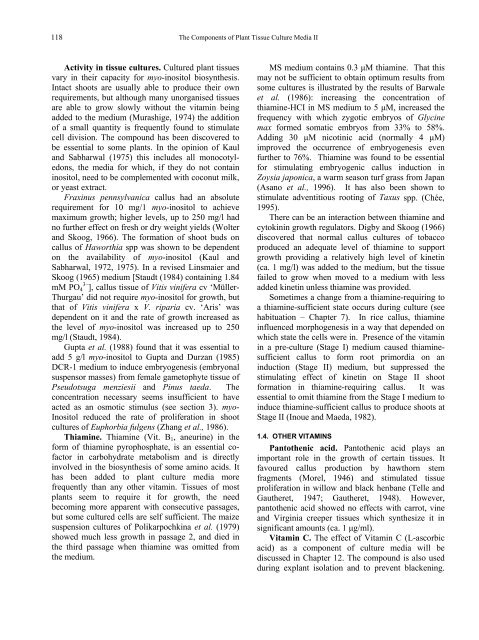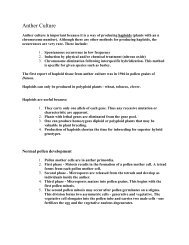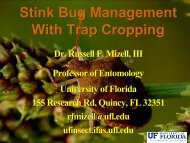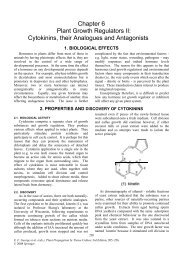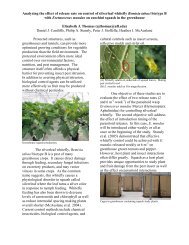The Components of Plant Tissue Culture Media II - Horticultural ...
The Components of Plant Tissue Culture Media II - Horticultural ...
The Components of Plant Tissue Culture Media II - Horticultural ...
Create successful ePaper yourself
Turn your PDF publications into a flip-book with our unique Google optimized e-Paper software.
118 <strong>The</strong> <strong>Components</strong> <strong>of</strong> <strong>Plant</strong> <strong>Tissue</strong> <strong>Culture</strong> <strong>Media</strong> <strong>II</strong><br />
Activity in tissue cultures. <strong>Culture</strong>d plant tissues<br />
vary in their capacity for myo-inositol biosynthesis.<br />
Intact shoots are usually able to produce their own<br />
requirements, but although many unorganised tissues<br />
are able to grow slowly without the vitamin being<br />
added to the medium (Murashige, 1974) the addition<br />
<strong>of</strong> a small quantity is frequently found to stimulate<br />
cell division. <strong>The</strong> compound has been discovered to<br />
be essential to some plants. In the opinion <strong>of</strong> Kaul<br />
and Sabharwal (1975) this includes all monocotyledons,<br />
the media for which, if they do not contain<br />
inositol, need to be complemented with coconut milk,<br />
or yeast extract.<br />
Fraxinus pennsylvanica callus had an absolute<br />
requirement for 10 mg/1 myo-inositol to achieve<br />
maximum growth; higher levels, up to 250 mg/l had<br />
no further effect on fresh or dry weight yields (Wolter<br />
and Skoog, 1966). <strong>The</strong> formation <strong>of</strong> shoot buds on<br />
callus <strong>of</strong> Haworthia spp was shown to be dependent<br />
on the availability <strong>of</strong> myo-inositol (Kaul and<br />
Sabharwal, 1972, 1975). In a revised Linsmaier and<br />
Skoog (1965) medium [Staudt (1984) containing 1.84<br />
mM PO4 3– ], callus tissue <strong>of</strong> Vitis vinifera cv ‘Müller-<br />
Thurgau’ did not require myo-inositol for growth, but<br />
that <strong>of</strong> Vitis vinifera x V. riparia cv. ‘Aris’ was<br />
dependent on it and the rate <strong>of</strong> growth increased as<br />
the level <strong>of</strong> myo-inositol was increased up to 250<br />
mg/l (Staudt, 1984).<br />
Gupta et al. (1988) found that it was essential to<br />
add 5 g/l myo-inositol to Gupta and Durzan (1985)<br />
DCR-1 medium to induce embryogenesis (embryonal<br />
suspensor masses) from female gametophyte tissue <strong>of</strong><br />
Pseudotsuga menziesii and Pinus taeda. <strong>The</strong><br />
concentration necessary seems insufficient to have<br />
acted as an osmotic stimulus (see section 3). myo-<br />
Inositol reduced the rate <strong>of</strong> proliferation in shoot<br />
cultures <strong>of</strong> Euphorbia fulgens (Zhang et al., 1986).<br />
Thiamine. Thiamine (Vit. B1, aneurine) in the<br />
form <strong>of</strong> thiamine pyrophosphate, is an essential c<strong>of</strong>actor<br />
in carbohydrate metabolism and is directly<br />
involved in the biosynthesis <strong>of</strong> some amino acids. It<br />
has been added to plant culture media more<br />
frequently than any other vitamin. <strong>Tissue</strong>s <strong>of</strong> most<br />
plants seem to require it for growth, the need<br />
becoming more apparent with consecutive passages,<br />
but some cultured cells are self sufficient. <strong>The</strong> maize<br />
suspension cultures <strong>of</strong> Polikarpochkina et al. (1979)<br />
showed much less growth in passage 2, and died in<br />
the third passage when thiamine was omitted from<br />
the medium.<br />
MS medium contains 0.3 μM thiamine. That this<br />
may not be sufficient to obtain optimum results from<br />
some cultures is illustrated by the results <strong>of</strong> Barwale<br />
et al. (1986): increasing the concentration <strong>of</strong><br />
thiamine-HCI in MS medium to 5 μM, increased the<br />
frequency with which zygotic embryos <strong>of</strong> Glycine<br />
max formed somatic embryos from 33% to 58%.<br />
Adding 30 μM nicotinic acid (normally 4 μM)<br />
improved the occurrence <strong>of</strong> embryogenesis even<br />
further to 76%. Thiamine was found to be essential<br />
for stimulating embryogenic callus induction in<br />
Zoysia japonica, a warm season turf grass from Japan<br />
(Asano et al., 1996). It has also been shown to<br />
stimulate adventitious rooting <strong>of</strong> Taxus spp. (Chée,<br />
1995).<br />
<strong>The</strong>re can be an interaction between thiamine and<br />
cytokinin growth regulators. Digby and Skoog (1966)<br />
discovered that normal callus cultures <strong>of</strong> tobacco<br />
produced an adequate level <strong>of</strong> thiamine to support<br />
growth providing a relatively high level <strong>of</strong> kinetin<br />
(ca. 1 mg/l) was added to the medium, but the tissue<br />
failed to grow when moved to a medium with less<br />
added kinetin unless thiamine was provided.<br />
Sometimes a change from a thiamine-requiring to<br />
a thiamine-sufficient state occurs during culture (see<br />
habituation – Chapter 7). In rice callus, thiamine<br />
influenced morphogenesis in a way that depended on<br />
which state the cells were in. Presence <strong>of</strong> the vitamin<br />
in a pre-culture (Stage I) medium caused thiaminesufficient<br />
callus to form root primordia on an<br />
induction (Stage <strong>II</strong>) medium, but suppressed the<br />
stimulating effect <strong>of</strong> kinetin on Stage <strong>II</strong> shoot<br />
formation in thiamine-requiring callus. It was<br />
essential to omit thiamine from the Stage I medium to<br />
induce thiamine-sufficient callus to produce shoots at<br />
Stage <strong>II</strong> (Inoue and Maeda, 1982).<br />
1.4. OTHER VITAMINS<br />
Pantothenic acid. Pantothenic acid plays an<br />
important role in the growth <strong>of</strong> certain tissues. It<br />
favoured callus production by hawthorn stem<br />
fragments (Morel, 1946) and stimulated tissue<br />
proliferation in willow and black henbane (Telle and<br />
Gautheret, 1947; Gautheret, 1948). However,<br />
pantothenic acid showed no effects with carrot, vine<br />
and Virginia creeper tissues which synthesize it in<br />
significant amounts (ca. 1 μg/ml).<br />
Vitamin C. <strong>The</strong> effect <strong>of</strong> Vitamin C (L-ascorbic<br />
acid) as a component <strong>of</strong> culture media will be<br />
discussed in Chapter 12. <strong>The</strong> compound is also used<br />
during explant isolation and to prevent blackening.


